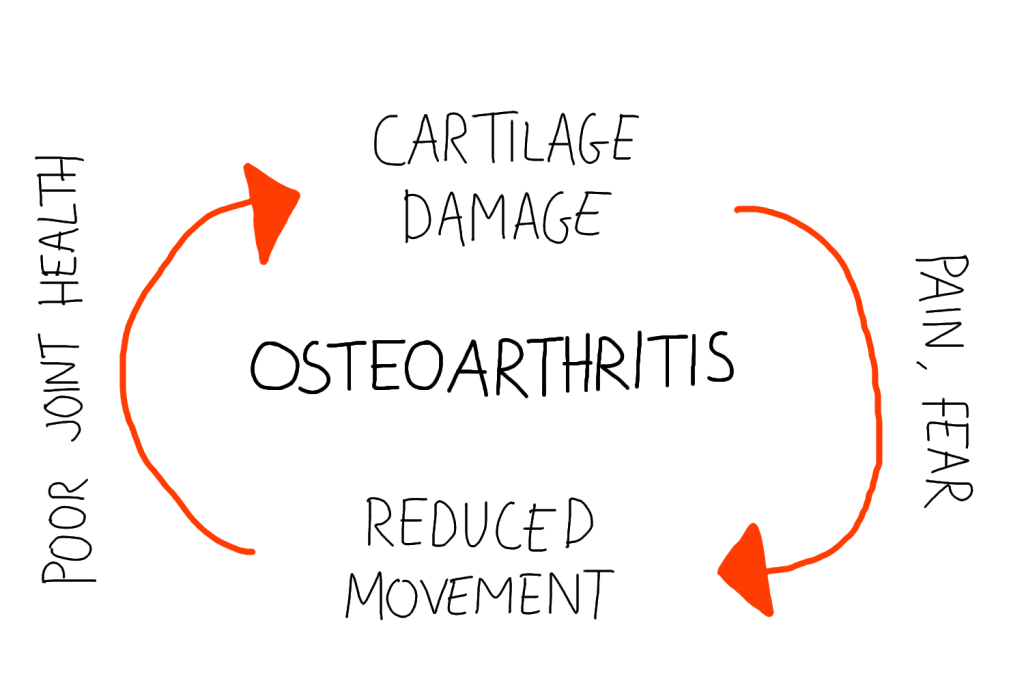It’s not often that someone books in with me for hand pain alone (arthritic or otherwise), it tends to be something they mention later. We can absolutely help if your main or only concerns are arthritic hands. The two main forms of arthritis that affect the hands are osteoarthritis (OA) and rheumatoid arthritis (RA).

Osteoarthritis (OA)
Osteoarthritis in the hands is no different to an arthritic hip or knee from a treatment perspective. No joints are out of your osteopath’s remit. The joints of the hand I see most affected by OA are in the thumb. The pain is often described as deep and achey, or sometimes grinding or catching.
Arthritic thumbs may be predisposed by injury, or just wear and tear. Either way, the process is the same.
- Cartilage is irritated
- Movement is reduced
- The cartilage is not receiving the necessary movement to push out waste and push in nutrients
- Cartilage degrades further and cycle continues

Although overuse can be a cause of arthritic hands, the treatment plan is to get the joints moving. Joints in the hand are quite easy to get moving when you know how to, and often the exercises I prescribe are based on the techniques I use during treatment. Alongside specific exercises, there are other activities that can help, such as:
- Knitting or crochet
- Playing an instrument
- Using therapeutic putty
Rheumatoid Arthritis (RA)
RA is a very different condition to OA. RA is an inflammatory disease where the body attacks itself (autoimmune). Joint swelling, pain, and loss of movement are some early signs. A general feeling of being under the weather is a common early symptom. Some joints are more affected than others, typically:
- Joints of the hands and feet
- Wrists and ankles
- Shoulders
- Elbows
- Neck
- TMJ (jaw)
In contrast to OA, where the cartilage is mechanically irritated, in RA the damage is done by inflammatory cells. These cells erode the joint surfaces, and in response to this, the body lays down excess cartilage and bone. This can cause deformities to the wrist and fingers.
Diagnosis should be confirmed with a blood test and potentially an X-ray or MRI. There are a range of medications available to help manage RA. Exercise and movement are important parts of an effective treatment plan to keep joints as mobile as possible.
Exercises for Arthritic Hands
Alongside treatment during your appointments, exercises are key for managing your arthritis. Here’s a video of exercises I commonly prescribe to my patients with osteoarthritic hands.
You should speak to a health professional before starting these exercises as they may not be appropriate for you. Your osteopath can give a recommendation for how frequently you should perform these, if they agree that they are suitable.
The Exercises
The aim of these exercises is to improve movement within the hand joints. I demonstrate a lot of traction or pulling- this can help you move a bit more with less discomfort.
Fingers
Focus on the flexion/extension (forward and backward) movement.
Thumb
For the joint closest to the nail, work as you did for the fingers. For the two joints lower down (one at the visible base of the thumb, and one closer to the wrist) you might benefit from a more circular movement.
Hands and Wrist
Where the bones of the hand are long and straight, movements that encourage sliding between adjacent fingers can be effective.
Further down the hand towards the wrist, the joints are all different shapes. Use a variety of hand holds and play around with traction to find something that feels beneficial.
Book an appointment in Buckinghamshire here to start managing your arthritic pain
